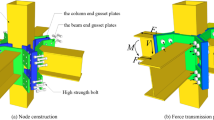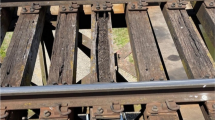Abstract
The nuclear fuel assembly is the core component of a nuclear reactor. In a pressurized water reactor fuel assembly, the top-connection structure connects the top nozzle to the guide thimble. Its performance reliability is essential for the stability of the nuclear fuel assembly. In this study, an assembly-oriented reliability analysis method for top-connection structures is presented by establishing an assembly-oriented top-connection structure parameter modeling method and a nonlinear contact gap and penetration correction method. A reliability model of the top-connection assembly structure, including multiple stochastic design variables, was constructed, and the overall reliability of the top-connection assembly structure was obtained via a Kriging model and Monte Carlo simulation. The acquired experimental data were consistent with real-world failure conditions, which verified the practicability and feasibility of the reliability analysis method proposed in this study.









Similar content being viewed by others
Data availability
The data that support the findings of this study are openly available in Science Data Bank at https://www.doi.org/10.57760/sciencedb.j00186.00077 and https://cstr.cn/31253.11.sciencedb.j00186.00077.
References
E.B. Agyekum, M.N.S. Ansah, K.B. Afornu, Nuclear energy for sustainable development: SWOT analysis on Ghana’s nuclear agenda. Energy Rep. 6, 107–115 (2020). https://doi.org/10.1016/j.egyr.2019.11.163
X.P. Guo, X.D. Guo, Nuclear power development in China after the restart of new nuclear construction and approval: a system dynamics analysis. Renew. Sustain. Energy Rev. 57, 999–1007 (2016). https://doi.org/10.1016/j.rser.2015.12.190
S.T. Ling, W.Q. Li, C.X. Li et al., Flow field fusion simulation method based on model features and its application in CRDM. Nucl. Sci. Tech. 33(3), 32 (2022). https://doi.org/10.1007/s41365-022-01022-0
D. Fan, T. Peng, Y. Tang et al., Periodicity and transversal pressure distribution in a wire-wrapped 19-Pin fuel assembly. Int. J. Energy Res. 45(8), 11837–11850 (2020). https://doi.org/10.1002/er.5809
V.I. Skalozubov, I.L. Kozlov, Y.A. Komarov et al., Analysis of nuclear safety in diversification of Westinghouse fuel assemblies at WWER-1000. Ядepнa фiзикa тa eнepгeтикa. 20(2), 159–163 (2019)
X. Wang, D. Wang, Q. Deng et al., Simulation of dynamic characteristics of NHR200-II fuel assembly. Nucl. Eng. Des. 379, 111255 (2020). https://doi.org/10.1016/j.nucengdes.2021.111255
NB/T 20057.3-2012. Reactor system design for pressurized water reactor nuclear power plants-core part 3: fuel assemblies (2012)
G. Yadigaroglu, M. Andreani, J. Dreier et al., Trends and needs in experimentation and numerical simulation for LWR safety. Nucl. Nucl. Eng. Des. 221, 205–223 (2003). https://doi.org/10.1016/S0029-5493(02)00339-4
D. Mourtzis, Simulation in the design and operation of manufacturing systems: state of the art and new trends. Int. J. Prod. Res. 58(7), 1927–1949 (2020). https://doi.org/10.1080/00207543.2019.1636321
M. Wang, Y. Wang, W. Tian et al., Recent progress of CFD applications in PWR thermal hydraulics study and future directions. Ann. Nucl. Energy. 150, 107836 (2021). https://doi.org/10.1016/j.anucene.2020.107836
Y. Wang, M. Wang, H. Ju et al., CFD simulation of flow and heat transfer characteristics in a 5× 5 fuel rod bundles with spacer grids of advanced PWR. Nucl. Eng. Technol. 52, 1386–1395 (2020). https://doi.org/10.1016/j.net.2019.12.012
J. Zhang, M. Wang, C. Chen et al., CFD investigation of the cold wall effect on CHF in a 5× 5 rod bundle for PWRs. Nucl. Eng. Des. 387, 111589 (2022). https://doi.org/10.1016/j.nucengdes.2021.111589
H. Wang, Z. Pu, F. Zhu et al., Simulation and analysis of new-type fuel assembly top connection structure. Nucl. Power Eng. 38(06), 163–166 (2017). https://doi.org/10.13832/j.jnpe.2017.06.0163
S. Liu, Strength Analysis of Pipe Seat Transport and Hoisting Conditions on PWR Fuel Assembly (Southwest Petroleum University, 2019)
Y. Yoo, K. Kim, K. Eom et al., Finite element analysis of the mechanical behavior of a nuclear fuel assembly spacer grid. Nucl. Eng. Des. 352, 110179 (2019). https://doi.org/10.1016/j.nucengdes.2019.110179
M.H. Duan, M.F. Zhao, A numerical research of the resistance characteristics of the bottom nozzle in the annular fuel assembly, in International Conference on Nuclear Engineering, vol. 51494 (American Society of Mechanical Engineers, 2018), p. V06BT08A046. https://doi.org/10.1115/ICONE26-82259
C.Y. Wu, M.T. Kao, C.C. Chieng et al., CFD analysis of PWR core top region: Top fuel assembly and top nozzle regions, in International Conference on Nuclear Engineering. ICONE18-29463 (2010), pp. 557–564. https://doi.org/10.1115/ICONE18-29463
M. Su, P. Chen, L. Kuang et al., Mechanical property study of CF3 fuel assembly bottom nozzle. Nucl. Power Eng. 39(S1), 62–65 (2018). https://doi.org/10.13832/j.jnpe.2018.S1.0062
Z. Wei, S. Du, X. Wang et al., Numerical simulation study on resistance characteristics of top nozzle in fuel assembly based on CFD. Nucl. Power Eng. 38(S2), 29–33 (2017). https://doi.org/10.13832/j.jnpe.2017.S2.0029
Š Dyk, V. Zeman, Impact vibrations of guide thimbles in nuclear fuel assembly. Arch. Appl. Mech. 87(2), 231–244 (2017). https://doi.org/10.1007/s00419-016-1189-6
Y. Xu, M. Conner, K. Yuan et al., Study of impact of the AP1000® reactor vessel upper internals design on fuel performance. Nucl. Eng. Des. 252, 128–134 (2012). https://doi.org/10.1016/j.nucengdes.2012.06.036
J. Zhao, S. Xu, W. Pan et al., A detailed model to predict mechanical characteristics of fuel assembly, in International Conference on Nuclear Engineering, vol. 86366 (American Society of Mechanical Engineers, 2022), p. V002T02A043. https://doi.org/10.1115/ICONE29-91931
ASME. Section III Division 1-Subsection NG, Core support structures (2003)
D. Meng, Y. Li, C. He et al., Multidisciplinary design for structural integrity using a collaborative optimization method based on adaptive approximation modelling. Mater. Des. 206, 109789 (2021). https://doi.org/10.1016/j.matdes.2021.109789
S. Ling, W. Li, T. Yu et al., Analysis and optimization research on latch life of control rod drive mechanism based on approximate model. Nucl. Eng. Technol. 53(12), 4166–4178 (2021). https://doi.org/10.1016/j.net.2021.06.012
R. Jin, W. Chen, T.W. Simpson, Comparative studies of metamodelling techniques under multiple modelling criteria. Struct. Multidiscip. Optim. 23(1), 1–13 (2001). https://doi.org/10.1007/s00158-001-0160-4
T. Chai, R.R. Draxle, Root mean square error (RMSE) or mean absolute error (MAE)?—Arguments against avoiding RMSE in the literature. Geosci. Model Dev. 7(3), 1247–1250 (2014). https://doi.org/10.5194/gmd-7-1247-2014
R.Y. Rubinstein, B. Melamed, Modern Simulation and Modeling (Wiley, New York, 1998)
Q. Pan, D. Dias, An efficient reliability method combining adaptive support vector machine and Monte Carlo simulation. Struct. Saf. 67, 85–95 (2017). https://doi.org/10.1016/j.strusafe.2017.04.006
Z. Wang, M. Broccardo, J. Song, Hamiltonian Monte Carlo methods for subset simulation in reliability analysis. Struct. Saf. 76, 51–67 (2019). https://doi.org/10.1016/j.strusafe.2018.05.005
D.V. Dao, H. Adeli, H.B. Ly et al., A sensitivity and robustness analysis of GPR and ANN for high-performance concrete compressive strength prediction using a Monte Carlo simulation. Sustainability 12(3), 830 (2020). https://doi.org/10.3390/su12030830
B.T. Pham, M.D. Nguyen, D.V. Dao et al., Development of artificial intelligence models for the prediction of compression coefficient of soil: an application of Monte Carlo sensitivity analysis. Sci. Total Environ. 679, 172–184 (2019). https://doi.org/10.1016/j.scitotenv.2019.05.061
S. Mordechai, Applications of Monte Carlo Method in Science and Engineering (InTech, 2011)
S.A. Olatubosun, Z. Zhang, Dependency consideration of passive system reliability by coupled stress–strength interference/functional relations of parameters approach. Reliab. Eng. Syst. Saf. 188, 549–560 (2019). https://doi.org/10.1016/j.ress.2019.04.009
Author information
Authors and Affiliations
Contributions
All authors contributed to the study conception and design. Material preparation, data collection, and analysis were performed by Ying-Dong Liu, Wen-Qiang Li, Jia-Hao Chen, Si-Tong Ling and Chang-Fu Wan. The first draft of the manuscript was written by Ying-Dong Liu, and all authors commented on previous versions of the manuscript. All authors read and approved the final manuscript.
Corresponding author
Ethics declarations
Conflict of interest
The authors declare that they have no conflict of interest.
Additional information
This work was supported by the National Natural Science Foundation of China (No. 52075350), the Major Science and Technology Projects of Sichuan Province (No. 2022ZDZX0001), and the Special City School Strategic Cooperation Project of Sichuan University and Zigong (No. 2021CDZG-3).
Rights and permissions
Springer Nature or its licensor (e.g. a society or other partner) holds exclusive rights to this article under a publishing agreement with the author(s) or other rightsholder(s); author self-archiving of the accepted manuscript version of this article is solely governed by the terms of such publishing agreement and applicable law.
About this article
Cite this article
Liu, YD., Li, WQ., Chen, JH. et al. Assembly-oriented reliability analysis method for the top-connection structure of a nuclear fuel assembly. NUCL SCI TECH 34, 82 (2023). https://doi.org/10.1007/s41365-023-01247-7
Received:
Revised:
Accepted:
Published:
DOI: https://doi.org/10.1007/s41365-023-01247-7




